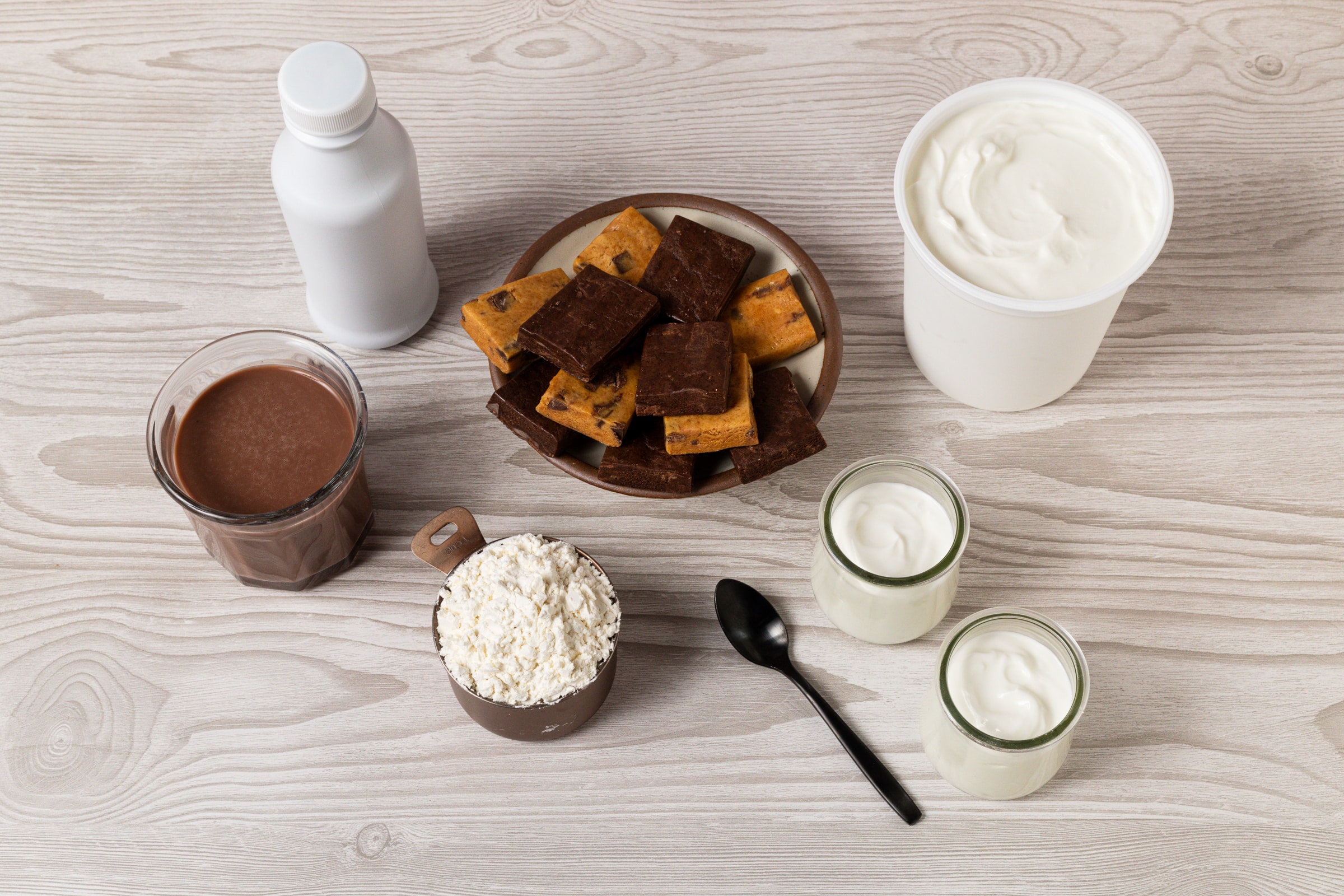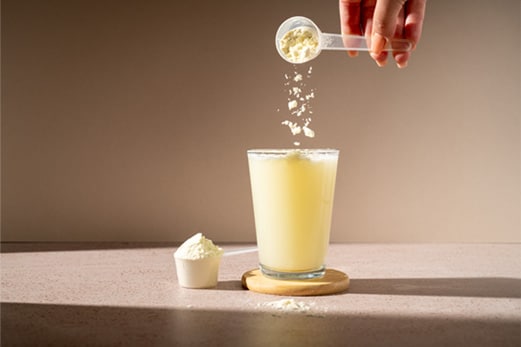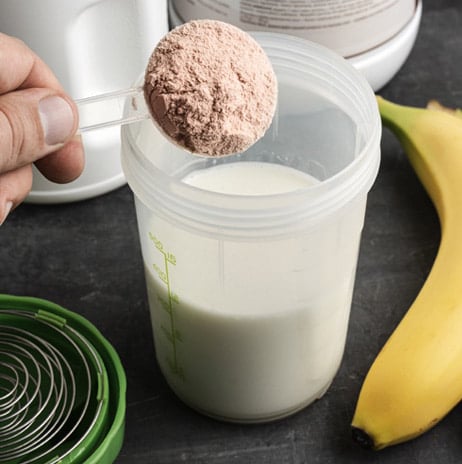
The Powerful List of Dairy Ingredients
Nature’s Complete Proteins
Fuel & Fiber With Carbs
Functional Fats
Beneficial "Bios"
Nature’s Complete Proteins
Proteins from Milk are the
Strong Inside
All proteins from milk are complete proteins, the highest protein qualityFocus on doing things well and producing a product acceptable to consumers More, and are a uniquely effective protein for the human body for all kinds of reasons.
Proteins from milk deliver all nine essential amino acidsSimple organic compounds that contain amino (-NH2 ) and carboyxl (-COOH) groups along with a side chain specific to each amino acid. There are approximately 500 amino acids in nature but only 20 are found in the human body. Amino acids chain together to form proteins., in just the right ratio, along with a unique combination of bioactive peptides (some which have a role in lower blood pressure) and minor proteins that have natural antibacterial properties (to boost your immune health). They keep you strong and feeling full, aid in weight loss, improve muscle tone and composition, and enhance your workout and recovery. That’s why proteins from milk are unbeatable when it comes to delivering the strong inside.

Different Types of Proteins from Milk
Do you know which proteins from milk contain little or no lactose? Which proteins from milk are leanest? Which have the highest concentrations of protein? Let’s take a deep dive into the different types of proteins from milk you might see on product ingredient labels.
Casein & Caseinates
CaseinProtein in milk that precipitates at pH 4.6. More is the major protein naturally found in milk (80% protein in milk is caseinProtein in milk that precipitates at pH 4.6. More, whey is 20%), containing nearly 100% protein in purest form. CaseinProtein in milk that precipitates at pH 4.6. More is naturally lactose-free and is considered to have a “delayed effect” as a slowly digested protein. One of nature’s most powerful proteins, caseinProtein in milk that precipitates at pH 4.6. More delivers protein, fat and mineralsGenerally refers to elements other than carbon (C), hydrogen (H), oxygen (O) and nitrogen (N) that are found in dairy products. The term often is used interchangeably with salts and ash. More to aid in many muscular-skeleton processes.
Commercial caseinProtein in milk that precipitates at pH 4.6. More is prepared from pasteurized skim milk with acid or rennet used to coagulate the caseinProtein in milk that precipitates at pH 4.6. More. A washing step is included to remove impurities such as lactose and mineralsGenerally refers to elements other than carbon (C), hydrogen (H), oxygen (O) and nitrogen (N) that are found in dairy products. The term often is used interchangeably with salts and ash. More and increases shelf life of the product.
Acid or rennet caseinProtein in milk that precipitates at pH 4.6. More are insoluble in water, and so to improve solubilityAbility of a liquid to dissolve another material. Examples: Lactose dissolving in water, alcohol dissolving in water. More and functionality, Caseinates are made by treating caseinProtein in milk that precipitates at pH 4.6. More with alkali (such as sodium, calcium, potassium, etc.).
Hydrolyzed Whey Protein
Hydrolyzed Whey Protein, or Whey Protein Hydrolysates, is processed by treating it with acid conditions and high heat to isolate the whey protein from a starting product of whey protein concentrate or whey protein isolate. This process creates small peptides, or bonds that link the amino acids. This, in turn, makes hydrolyzed whey protein easy for the body to absorb.
Manufacturers typically use whey protein concentrates as starting material to produce protein hydrolyzed products with higher protein contents for use in products like post-exercise drinks.
Lactoferrin
Bovine Lactoferrin is a biologically active milk protein isolated from fresh cow’s milk or fresh whey, and is an iron-binding protein. Colostral Lactoferrin is a biologically active milk protein isolated from fresh colostrum.
When lactoferrin is produced alone, it has a high purity compared to enriched products, and has several immune system-boosting properties. With a high protein level, its unique quality is that it has a light red color and is highly soluble.
Micellar Casein
Micellar CaseinDry form of microfiltered (MF) milk. A portion of the whey proteins have been removed so that the casein to whey protein ratio is no longer the 80:20 ratio typical in milk. Ratio of casein to whey proteins typically ranges between 82:18 and 95:5. Product may also be referred to as native phosphocasein. More is made from microfiltered milk and contains caseinProtein in milk that precipitates at pH 4.6. More in a higher concentration than in milk. Microfiltration alters the casein-to-whey raio between ranges of 82%:18% and 95%:5%. Micellar CaseinDry form of microfiltered (MF) milk. A portion of the whey proteins have been removed so that the casein to whey protein ratio is no longer the 80:20 ratio typical in milk. Ratio of casein to whey proteins typically ranges between 82:18 and 95:5. Product may also be referred to as native phosphocasein. More is basically the dry form ofb microfiltered milk, and is often used in sports nutrition products in concentrated form or as a substitute for other caseinProtein in milk that precipitates at pH 4.6. More ingredients. It is considered to have a “delayed effect” as a slowly digested protein due to the high caseinProtein in milk that precipitates at pH 4.6. More content levels.
Milk Protein Concentrate (MPC)
Milk Protein Concentrates are made by selectively removing lactose from skim milk, which concentrates proteins in the same ratio as found in milk (caseinProtein in milk that precipitates at pH 4.6. More at 80% to wheyLiquid obtained from cheese manufacture. More at 20%). MPCs are available as an ingredient in concentrations from 42% to 80-85%, and are low in lactose. Due to their caseinProtein in milk that precipitates at pH 4.6. More/whey blend, utilizing MPCs in products can yield optimal results in muscle-mass gain.
Milk Powders
Milk powders have long been added to products like toddler foods, formulations for vulnerable individuals, those who are pregnant and lactating mothers. The addition of milk powders like Dry Whole Milk and Nonfat Dry Milk can help improve the amino acid profiles of products and improve the overall protein qualityFocus on doing things well and producing a product acceptable to consumers More in products like cereal or grain products. With a concentration of about 34% protein, milk powders are used in a variety of products because of their functional properties.
Milk Protein Isolate (MPI)
Milk Protein Isolate is manufactured when extra filtration further removes lactose from milk protein concentrates to make an ingredient with over 90% protein. MPIs contain the same caseinProtein in milk that precipitates at pH 4.6. More to wheyLiquid obtained from cheese manufacture. More ratio as milk (about 80/20) and is virtually lactose free. With this balance of the caseinProtein in milk that precipitates at pH 4.6. More to whey proteinProtein in milk that remains in water phase after casein precipitates. More blend, it is one of the most optimal proteins to digest to yield optimal results in muscle-mass gain.
“Native” Whey (Milk Whey)
Native Whey (or Milk WheyLiquid obtained from cheese manufacture. More) is derived directly from milk through filtration techniques that produce micellar caseinDry form of microfiltered (MF) milk. A portion of the whey proteins have been removed so that the casein to whey protein ratio is no longer the 80:20 ratio typical in milk. Ratio of casein to whey proteins typically ranges between 82:18 and 95:5. Product may also be referred to as native phosphocasein. More rather than the cheesemaking process. In terms of use, it has come on the scene more recently as an ingredient added to sports and medical nutrition products. Native whey is very low in lactose, contains no fat, and is considered a “fast acting” protein for its fast absorption. It can be produced in levels from 34-80% for Milk WheyLiquid obtained from cheese manufacture. More Concentrations (mWPCs) or 90% for Milk WheyLiquid obtained from cheese manufacture. More Isolates (mWPIs), and cannot contain less than 25% protein.
Whey Protein Concentrate (WPC)
Whey Protein Concentrate is one of the most recognizable proteins from milk and can range in protein concentration from 34% protein (found in products like bars and shakes) to 80% protein (like powdered supplements). WPCWhey protein concentrate More contains some lactose (4%-8%), fat, mineralsGenerally refers to elements other than carbon (C), hydrogen (H), oxygen (O) and nitrogen (N) that are found in dairy products. The term often is used interchangeably with salts and ash. More, and moisture, and is considered a “fast acting” protein for its fast absorption. WPCWhey protein concentrate More is a co-product of the cheesemaking process and is an ingredient powerhouse for all its capabilities.
Whey Protein Isolate (WPI)
Whey Protein Isolate (WPI) is the most concentrated form of whey proteinProtein in milk that remains in water phase after casein precipitates. More available as an ingredient, with over 90% protein. It contains little or no lactose, is very low in fat, and considered a “fast acting” protein for its fast absorption. It is often used as a general protein supplement, and for its functionality in products like yogurts and puddings (gelation), toppings and fillings (whipping), meat and sausage (water binding), ice cream, margarine, and mayonnaise (emulsification).
Whey Protein Phospholipid Concentrate & Infant Formula Grade WPPC
Whey Protein Phospholipid Concentrate is a co-product of producing Whey ProteinProtein in milk that remains in water phase after casein precipitates. More Isolate (90+% protein) through microfiltration resulting in a product that is a mixture of fat and protein. The proteins are soluble in WPPCWhey protein phospholipid concentrate More, while the fat composition resembles the composition of whey creamSmall fat globules that were not trapped within the cheese matrix and go with the whey when it is drained from the curd. More. WPPC includes the Milkfat Globule Membrane, a more recently discovered ingredient, as a powerful ingredient with incredible infant and aging benefits. WPPCWhey protein phospholipid concentrate More is also known as procream, reduced lactose concentrated wheyWhey where a portion of the water has been removed leaving all other constituents in the same relative proportions. More, and concentrated wheyWhey where a portion of the water has been removed leaving all other constituents in the same relative proportions. Morewhey proteinProtein in milk that remains in water phase after casein precipitates. More.

Choosing between Isolates vs. Concentrates
The main difference between these ingredients lies within how much protein you’re receiving per scoop. Isolates tend to contain 90% or more protein per scoop (typically making them safer for those with lactose intolerance) whereas concentrates can contain 34-80% protein. Concentrates will contain other necessary macronutrients like fat and carbohydrates to make up the remaining calories. While isolates may get you more bang for your protein buck, either can be a great supplement to a balanced, food-first approach to health and wellness when you’re looking to fill out your proteins.
How Proteins from Milk are Produced

Simple Process. Low Waste. High Yield.
Extracting proteins from milk is simple and relies only on pressure and filtration, which results in minimally processed protein. And unlike many plant-based proteins that are extracted using harsh treatments and added artificial chemicals, most proteins from milk are manufactured mere miles from where the milk was collected, which reduces the carbon footprint of this process.
Extracting proteins from milk is also a low waste process. Milk is 100% edible, whereas a lot of other sources of plant-based proteins may produce yields less than 35%. Simple processing, local manufacturing and modern filtration keeps yields high, which increases the sustainability of making proteins from milk.
Looking for a deeper dive into how different proteins from milk are made? Let’s break it down by type:
Concentrates
To make protein from milk concentrate, whole milk is first separated into cream and skim milk. The skim milk is pasteurized, then fractionated using ultrafiltration to make a skim concentrate that is lactose-reduced.
This process naturally separates milk components according to their molecular size. Milk passes through a membrane that allows some of the lactose, mineralsGenerally refers to elements other than carbon (C), hydrogen (H), oxygen (O) and nitrogen (N) that are found in dairy products. The term often is used interchangeably with salts and ash. More and water to cross through. The caseinProtein in milk that precipitates at pH 4.6. More and wheyLiquid obtained from cheese manufacture. More proteins, however, do not pass through the membrane due to their larger molecular size and are therefore concentrated. The proteins, lactose and mineralsGenerally refers to elements other than carbon (C), hydrogen (H), oxygen (O) and nitrogen (N) that are found in dairy products. The term often is used interchangeably with salts and ash. More that do not go through the membrane are then spray-dried to form a powder.
A similar process is applied to sweet wheyWhey that has an insignificant conversion of lactose to lactic acid. More (co-product of cheese manufacturing) to obtain whey proteinProtein in milk that remains in water phase after casein precipitates. More concentrate.
Isolates
Two separation methods are widely used for whey proteinProtein in milk that remains in water phase after casein precipitates. More isolates. One method utilizes ion exchangers, which extract whey proteinProtein in milk that remains in water phase after casein precipitates. More from the wheyLiquid obtained from cheese manufacture. More stream (usually a co-product of cheese manufacturing) according to the surface charge characteristics of the molecule.
The second method, membrane filtration (typically a combination of microfiltration and ultrafiltration), uses molecular size as the basis for separating components from the wheyLiquid obtained from cheese manufacture. More stream. In this process, simple pressure is applied across a membrane surface which forces smaller molecules through the membrane while larger molecules are retained.
Both methods yield a very high protein to non-protein product ratio, resulting in protein isolates that are typically at least 90% protein, and contain very low levels of lactose.
Micellar Casein and Milk Whey (“native” whey)
These concentrated milk protein products are produced using microfiltration of skim milk, which modifies the casein-to-whey protein ratio compared to that found in milk. The casein-to-whey protein ratio typically ranges between 82:18 and 95:5 for commercially available micellar caseinDry form of microfiltered (MF) milk. A portion of the whey proteins have been removed so that the casein to whey protein ratio is no longer the 80:20 ratio typical in milk. Ratio of casein to whey proteins typically ranges between 82:18 and 95:5. Product may also be referred to as native phosphocasein. More products. Micellar caseinDry form of microfiltered (MF) milk. A portion of the whey proteins have been removed so that the casein to whey protein ratio is no longer the 80:20 ratio typical in milk. Ratio of casein to whey proteins typically ranges between 82:18 and 95:5. Product may also be referred to as native phosphocasein. More is an ingredient most often found in sports and nutrition products.
The whey-enriched stream alternatively is called milk whey or “native” wheyLiquid obtained from cheese manufacture. More. This ingredient is also used in sports products and has potential in infant nutrition. It can be found in blends of whey proteins as well.
Casein and Caseinates
Casein (acid) is obtained by coagulating skim milk, followed by separating, washing and drying steps. Rennet casein, an ingredient used in some cheeses, is made using enzymes. To facilitate applications in food products and drinks, casein may be further processed into caseinates (sodium, calcium, etc.).
Caseinates are found in a myriad of products where they act as natural emulsifiersCompounds that stabilize an emulsion. Examples: Egg yolk, glycerin esters and sugar esters More, providing body and “creaminess.” Because they are lactose-free, caseinates are often used in non-dairy creamers, for example.
Milk Powders
Milk powders are simply made from whole or skim milk, concentrated by evaporation, then spray-dried.
They are used worldwide as an ingredient in all food categories, and can be used when fluid milk is not available, or to fortify products for nutritional or functional reasons.

Not all Proteins are Created Equal: Plant v. Milk Proteins
There are 20 amino acidsSimple organic compounds that contain amino (-NH2 ) and carboyxl (-COOH) groups along with a side chain specific to each amino acid. There are approximately 500 amino acids in nature but only 20 are found in the human body. Amino acids chain together to form proteins. your body requires to be strong inside. Nine of them cannot be made by the human body and need to be absorbed by your body through your diet. These are called essential amino acidsSimple organic compounds that contain amino (-NH2 ) and carboyxl (-COOH) groups along with a side chain specific to each amino acid. There are approximately 500 amino acids in nature but only 20 are found in the human body. Amino acids chain together to form proteins.. While a few of them can be found in different combinations in many foods, only a handful of foods are considered a natural source of all nine essential amino acidsSimple organic compounds that contain amino (-NH2 ) and carboyxl (-COOH) groups along with a side chain specific to each amino acid. There are approximately 500 amino acids in nature but only 20 are found in the human body. Amino acids chain together to form proteins.. These foods are classified as complete proteins.
Many plant-based proteins only deliver some of the necessary nutrients, making them incomplete proteins. Also, anti-nutrient factors may be naturally present in some sources of plant-based protein (phytates in soy for example) which may further decrease their protein quality for human consumption.
Complete Proteins
Milk, meat, fish, soy, and quinoa not only contain high levels of protein, they are also complete proteins, meaning they are a natural source of the nine amino acidsSimple organic compounds that contain amino (-NH2 ) and carboyxl (-COOH) groups along with a side chain specific to each amino acid. There are approximately 500 amino acids in nature but only 20 are found in the human body. Amino acids chain together to form proteins. considered essential for vital bodily functions, like nutrient absorption, tissue repair, and protein synthesis.
vs
Incomplete Proteins
Grains, legumes, nuts, and seeds are natural sources of protein, but none contain all nine essential amino acidsSimple organic compounds that contain amino (-NH2 ) and carboyxl (-COOH) groups along with a side chain specific to each amino acid. There are approximately 500 amino acids in nature but only 20 are found in the human body. Amino acids chain together to form proteins.. They are therefore considered incomplete proteins.
Where can Proteins from Milk be used?
Check out the Functionality & Applications section to learn more about how carbohydrates from milk can be used!
